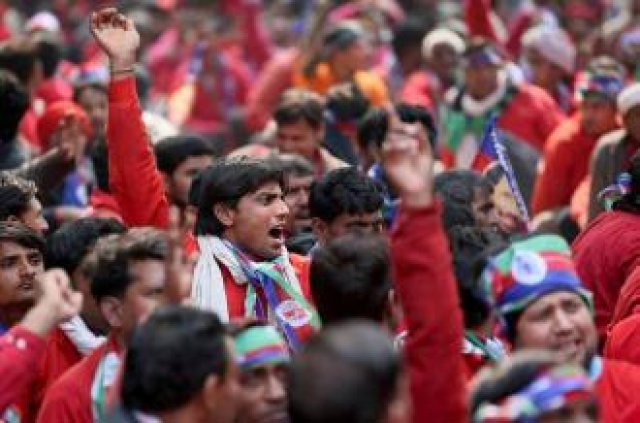
The dominant media narrative about the two-day all-India strike, called by trade unions for February 20 and 21, was one of “hooliganism” by workers and inconvenience caused to the “public”.
As usual, the main demands of the striking workers found little space in the media's discussion of the strike. The working class — usually invisible, both at the workplace and where they live — attained visibility on TV screens only as a “mob”.
Workers, whose labour is, after all, the source of all production, are seen and shown as a source of wanton and mindless destruction.
On February 20, the media used images of stone-throwing, arson and looting in Noida on the first day of the strike. What followed was an all-out crackdown on workers all across Noida.
The strike, however, was successful in most of the vital sectors of India's economy: oil, telecommunications, mining, defence, power, ports and docks, insurance, transportation, postal, banking and taxation. Government employees also took part in the nationwide strike.
Industrial workers all over the country shut down production in both public and private industrial centres. In the National Capital Region (NCR), the Gurgaon-Dharuhera industrial belt of Haryana remained virtually closed on the second day of the strike. Contract workers and workers of the unorganized sector participated fully in the strike everywhere. Several states — including Kerala, Bihar and Jharkhand — observed a complete bandh (general strike).
The workers were demanding measures to curb price rises and unemployment. They were demanding that labour laws be enforced strictly. They were demanding compulsory registration of trade unions within 45 days, and immediate ratification of the ILO Conventions that concern workers' right to organise and collective bargaining.
They were protesting against the rampant casualisation of work, in both public and private sector, in blatant violation of the law. They were demanding that mandated minimum wages be paid.
The government and the industrialists who accuse workers of lawlessness are themselves guilty of systematically abusing the laws enacted to protect workers' rights.
In the Wazirpur Industrial Area of Delhi, about 20,000 workers came out on the streets on the second day of the strike in a protest march organised by various trade unions, including the All India Central Council of Trade Unions (AICCTU) and the Center of Indian Trade Unions (CITU).
For workers employed in the factories in this industrial area, one of the key issues is the blatant and open denial of minimum wages. Some years ago, a struggle to demand payment of minimum wages in one factory was met with a “united” opposition of all the industrialists in the area, and the local MLA as well.
The struggle succeeded only thanks to the groundswell of support from workers across factories and their families, most of whom are migrants living in the local illegal slum cluster that abuts a railway track.
When a worker has been killed in a workplace accident and the management tries to fudge records to avoid paying his wages and compensation, women from this slum cluster, most of them married to factory workers, have spontaneously surrounded the factory and forced the management to pay what is owed them.
In the slum cluster, where workers live with the constant threat of eviction, basic amenities such as water, drainage and sanitation are not available.
Every time there is a major all-India strike, the response here is huge. During the strike, the anger of the young workers is palpable, and not uncommonly, factories that remain open and barricade their workers inside to prevent them from joining the strike are targeted.
This is not wanton vandalism — it is a bid to free fellow workers from the factory that uses coercion to prevent workers from exercising their right to strike.
This time, too, the workers enforced the strike and blockaded Delhi's Ring Road for a couple of hours. But there was no looting: what was seen was the collective, organised anger and energy of the working class.
Working class anger and outrage, contrary to the media construction, is well-reasoned and has a strong basis. The main basis for this anger is the blatant strangulation of industrial democracy, denial of rights to organise and unionise, and the open violation of labour laws, including minimum wage and contract work laws.
[Abridged from Economic and Political Weekly. Kavita Krishnan is secretary of the All India Progressive Women's Association.]
